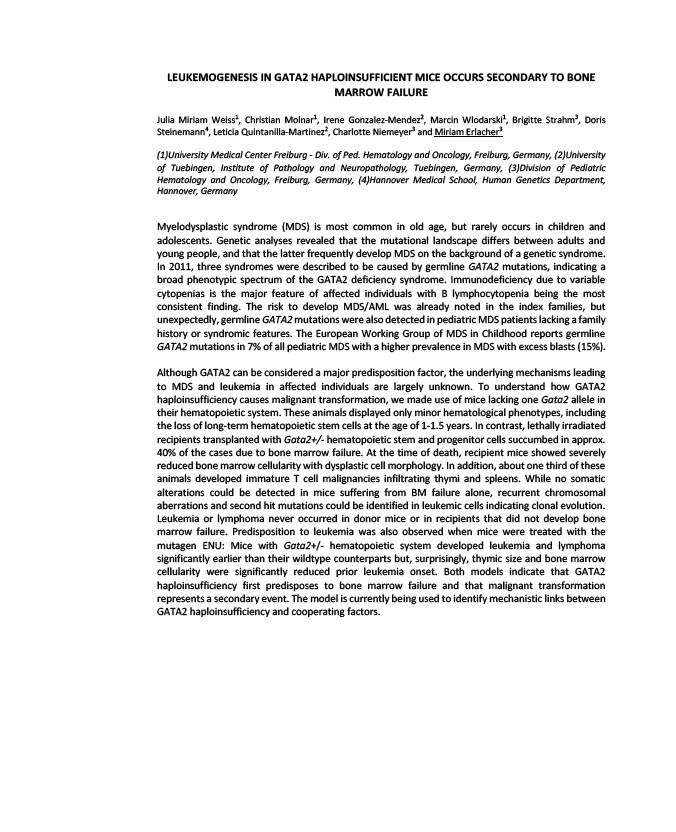
LEUKEMOGENESIS IN GATA2 HAPLOINSUFFICIENT MICE OCCURS SECONDARY TO BONE
MARROW FAILURE
Julia Miriam Weiss1, Christian Molnar1, Irene Gonzalez-Mendez2, Marcin Wlodarski1, Brigitte Strahm3, Doris
Steinemann4, Leticia Quintanilla-Martinez2, Charlotte Niemeyer3 and Miriam Erlacher3
(1)University Medical Center Freiburg - Div. of Ped. Hematology and Oncology, Freiburg, Germany, (2)University
of Tuebingen, Institute of Pathology and Neuropathology, Tuebingen, Germany, (3)Division of Pediatric
Hematology and Oncology, Freiburg, Germany, (4)Hannover Medical School, Human Genetics Department,
Hannover, Germany
Myelodysplastic syndrome (MDS) is most common in old age, but rarely occurs in children and
adolescents. Genetic analyses revealed that the mutational landscape differs between adults and
young people, and that the latter frequently develop MDS on the background of a genetic syndrome.
In 2011, three syndromes were described to be caused by germline GATA2 mutations, indicating a
broad phenotypic spectrum of the GATA2 deficiency syndrome. Immunodeficiency due to variable
cytopenias is the major feature of affected individuals with B lymphocytopenia being the most
consistent finding. The risk to develop MDS/AML was already noted in the index families, but
unexpectedly, germline GATA2 mutations were also detected in pediatric MDS patients lacking a family
history or syndromic features. The European Working Group of MDS in Childhood reports germline
GATA2 mutations in 7% of all pediatric MDS with a higher prevalence in MDS with excess blasts (15%).
Although GATA2 can be considered a major predisposition factor, the underlying mechanisms leading
to MDS and leukemia in affected individuals are largely unknown. To understand how GATA2
haploinsufficiency causes malignant transformation, we made use of mice lacking one Gata2 allele in
their hematopoietic system. These animals displayed only minor hematological phenotypes, including
the loss of long-term hematopoietic stem cells at the age of 1-1.5 years. In contrast, lethally irradiated
recipients transplanted with Gata2+/- hematopoietic stem and progenitor cells succumbed in approx.
40% of the cases due to bone marrow failure. At the time of death, recipient mice showed severely
reduced bone marrow cellularity with dysplastic cell morphology. In addition, about one third of these
animals developed immature T cell malignancies infiltrating thymi and spleens. While no somatic
alterations could be detected in mice suffering from BM failure alone, recurrent chromosomal
aberrations and second hit mutations could be identified in leukemic cells indicating clonal evolution.
Leukemia or lymphoma never occurred in donor mice or in recipients that did not develop bone
marrow failure. Predisposition to leukemia was also observed when mice were treated with the
mutagen ENU: Mice with Gata2+/- hematopoietic system developed leukemia and lymphoma
significantly earlier than their wildtype counterparts but, surprisingly, thymic size and bone marrow
cellularity were significantly reduced prior leukemia onset. Both models indicate that GATA2
haploinsufficiency first predisposes to bone marrow failure and that malignant transformation
represents a secondary event. The model is currently being used to identify mechanistic links between
GATA2 haploinsufficiency and cooperating factors.